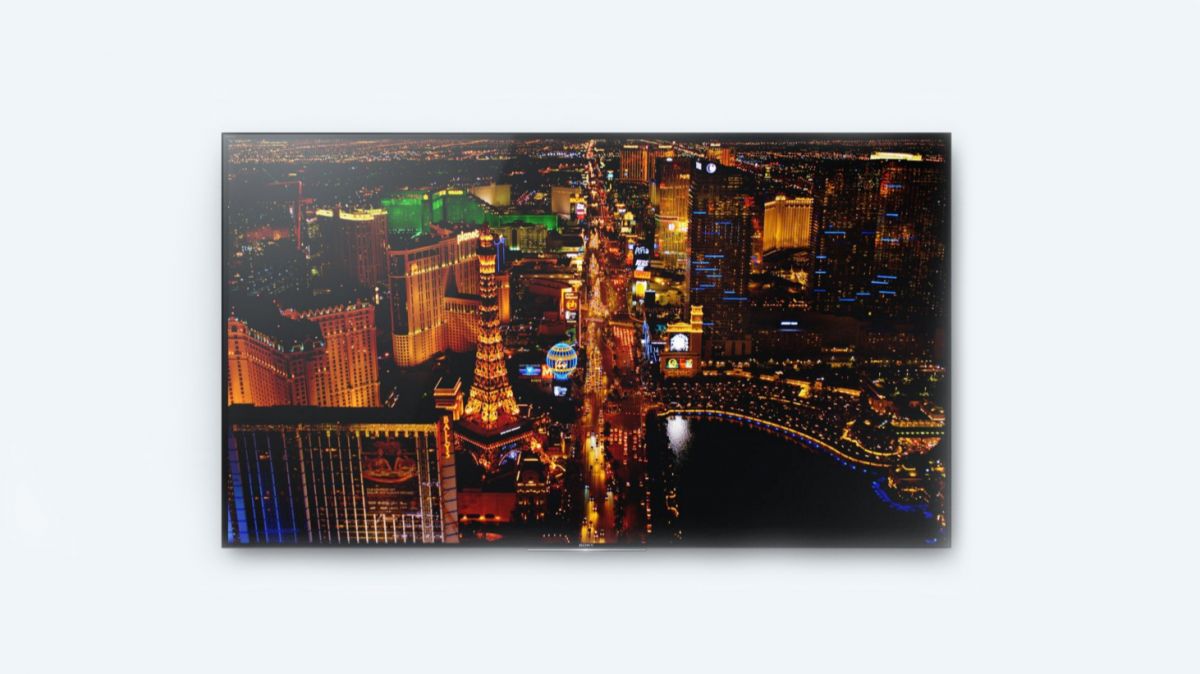
It’s increasingly looking like the battle for picture supremacy between next generation 4K HDR (High Dynamic range) LED TVs will be fought behind the screen, with competing backlighting technologies.
Being able to serve up the kind of peak highlights required for traffic-stopping HDR ultimately comes down to brightness, and the most effective weapon is a full array backlight. But, most of the time, in order to get the kind of brightness needed for HDR there are big trade-offs in terms of cost and screen depth.
So it speaks volumes that the XD93 series, this year’s Sony HDR champion (if that 5000nit prototype monster seen at CES doesn’t hit the high streets), is preposterously thin. Just 35mm at its apex, it achieves its impossible thinness with an ingenious Slim Backlight Drive that’s able to deliver the kind of brightness and contrast required for effective HDR.
The XD93 review unit sent to techradar is a 55-incher that retails for $2000, but it’s also available as the 65-inch KD-65XD9305 starting at $2800.
Dressed to impress
There’s no getting away from the fact that this is a fine-looking flatscreen. To signify its high-end credentials, there’s a gold vein running through the edge of the frame. This apes the gold design affectation seen on Sony’s High Res Audio speakers.
The set sits on a refreshingly practical central pedestal, which means you can park it on pretty much any TV furniture you like without the need to break out the ruler to see if it will fit. Also in the box is a simple hang-on-the-wall loop bracket.
Connections include four HDMIs, a SCART, component/composite AV inputs, plus three USBs (one fast 3.0); however, curiously these USB ports seemingly don’t qualify as an input within the Android shelf interface. There’s also Ethernet and an optical digital audio output.
All the HDMI inputs are HDCP 2.2-enabled, which means you can use them with external 4K sources, like a Sky Q STB or 4K Blu-ray player. Remember, though, that this Sony’s HDMI inputs need to be manually assigned to support HDR and associated high-end picture parameters (designated Enhanced HDMI) in the menu jungle.
Onboard is a dual-band Wi-Fi antenna that runs on both the 2.4Ghz and 5.0Ghz frequencies. There’s also Wi-Fi Direct and Google Cast.
Around the back, Sony has introduced a neat cable management system to keep things tidy. Cables run from the HDMI board, through plastic gulleys, until they flow from the back of the pedestal. This works fine as long as you don’t use overly chunky cabling, however using all the ports may also prove congestive.
The remote control supplied with the XD93 is unique to say the least. Sony has jettisoned traditional buttons in favour of rubberised bumps and ridges. The result is as awkward to use as you might imagine. It’s super clicky, too. Android OS is a tough enough landscape as it is, but this just makes things a magnitude worse. It does come with an integrated Bluetooth microphone though, so at least you can voice search. That said, speech recognition is surprisingly reliable.
The set boasts twin Freeview and dual satellite tuners. Significantly, Sony also provides a YouView overlay for terrestrial TV watchers. This cleverly integrates all the main channel catch-up media players, which is to say BBC iPlayer, ITV Hub, All 4 and Demand 5.

The smart OS is, of course, Android-based. It’s home to Netflix and Amazon Instant Video, both of which are 4K-enabled, as well as YouTube, Wuaki.tv, Dailymotion, the BBC’s sport and news apps, plus more of dubious calibre.
The Android TV platform remains something of an acquired taste. While Panasonic and LG have gone minimalist with their smart offerings, Android keeps things busy. The main Home page is stacked with shelves, from tutorials to a plethora of featured apps, then inputs and then more apps. The Settings menu sits at the bottom of the home screen stack.
There is some relief, though. To jump to picture controls, you can use the Action Menu. Sony also offers up a browseable content bar which encourages you to mooch through curated content, be it live broadcasts, iPlayer, YouTube, Netflix or your own connected devices.
For all its surface elegance, general usability is a tad wonky.
For example, you can’t access the picture menus when streaming a show from Amazon, because you get thrown out of the app as soon as you call them up. Similarly, Netflix goes into pause when you do the same, with the result being that you can’t see what effect changing a setting has because the frozen Netflix image is obscured by a knocked back wash over it. You can at least experiment with YouTube.
The set isn’t particularly fast to navigate, either. For better or worse, you just eventually get used to the awkward pauses between commands.
And that rubberized no-button control is as as much fun to wield as a buttered squid. (Hint: not much fun.)
Picture performance
Interestingly, Sony has opted not to use any official Ultra HD Premium branding on its 4K televisions this year, despite the XD93 meeting the required specification to carry the badge, and despite the fact that Sony is a member of the UHD Alliance. It says that it would prefer to keep its HDR branding consistent.
For what it’s worth, the set doesn’t look as outrageously bright as the Panasonic DX902. But the benefits of HDR content are still immediately noticeable. This screen boasts images that are sharp, vibrant and contrasty.
At the heart of it all is Sony’s X1 processor. Engineers have reportedly improved noise reduction and further refined HD upscaling this season. Onscreen performance is certainly a little different – in a good way – from last year.

To improve contrast, the new Slim Backlight Drive design utilises two LED light modules, paired with dual light guides which split screen coverage 50/50. The technique allows the set to effectively switch off illumination to one half of the screen, while backlighting objects in the other, thereby maxing out contrast. Sony suggests its Slim Backlight Drive is comparable to a Full Array LED backlight, but without the bulk or cost.
For the most part it works well, but some content suffers from a weird Guiness Black & Tan effect, caused by the antonymous light steerage.
Aiding contrast this season is X-tended Dynamic Range PRO, said to triple the set’s dynamic range over previous edge-lit TVs.
A killer HDR test sequence of fireworks (authored by Japanese post production house Q-Tech), betrays a lot of what’s going on with the backlight. While the set doesn’t deliver the consistent blacks you’d expect from OLED, it at least does a good job of being largely benign. There’s a slightly hazy consistency to the blacks, but this doesn’t diminish the explosive vibrancy of the fireworks. The colour gamut of the panel is rated at over 90 per cent of the DCI P3 spectrum.
Picture presets cover most content types. There’s Standard (a well judged all-rounder), Vivid, Custom, Cinema Pro, Cinema Home, Sports, Animation and Game as well as photo modes. Depending on the source, you might have HDR Video, too. The HDR Video setting is the automatic default for any HDR10 content (the industry standard) – you can’t navigate away to a different setting.
Conversely, you can apply HDR Video to non-HDR sources, but it’s not recommended.

When HDR Video processing is used on SDR sources, the set is left to interpolate a greater colour volume and blast out peak highlights. In Gravity (Blu-ray), the establishing shot of planet Earth literally appears to be reflecting the sun. Clouds gleam and the space shuttle, as it grows from speck to ship in the right hand corner, glinting just the way you might imagine it would. But highlights are quickly blown out.
Interestingly, the TV looks consistently better with its light sensor left on rather than off. Going back to Gravity, with the light sensor left off Planet Earth is flat and overly bright with the sensor defeated. Turned on, you can see more convincing depth to the image. The light sensor is on by default with real HDR content, and can’t be turned off.
The quality of the set’s HD upscaling is extremely good, producing images which look naturally pixel dense. It does a fabulous job with Blu-ray and OTT streaming services.
4K picture quality is also uniformly terrific. The set support HDR on 4K Netflix, and Marco Polo, the first show to be streamed in HDR, benefits from the brilliant use of natural lighting (licks of flame look genuinely hot) and the richer colour palette that the stream offers.

4K HDR Blu-ray looks even more dramatic. San Andreas (4K HDR Blu-ray) is alive with dazzling highlights, with flaring Californian sun and glinting skyscrapers. The effect is almost three dimensional. Incidentally, the screen is indeed 3D enabled, however no Active Shutter glasses are supplied in the box.
Let’s not shout about the sound
Sony’s audiophile wedge TV design, with front-facing speakers, is now officially history.
So let’s cut to the chase: this TV doesn’t sound great. Indeed, even at the best of times audio often sounds strangely disconnected from the picture. I reckon you’ll want to budget for an exterior audio solution (be it a sound bar or AV receiver) sooner rather than later.
The XD93 is a striking high-end Ultra HD telly. The design is minimalist but beautiful, and the implementation of Sony’s Slim Backlight Drive proves an ingenious solution to the difficult problem of delivering high contrast HDR without the aid of a full array backlight.
The set manages to be contrasty offering a real HDR viewing experience, and image quality is fittingly impressive.
There are caveats, though.
The Android smart platform remains difficult to love and Sony’s new-style remote control errs on the wrong side of ghastly. But with 4K HDR Netflix onboard, top motion handling and some excellent connectivity, you may well opt to take the rough with the smooth.
We liked
The Sony KD-55XD9305 is a gorgeous-looking 4K screen, with advanced functionality and high level of picture performance. It does a great job upscaling HD content, and offers a largely spectacular UHD picture performance.
With a quartet of HDCP 2.2-enabled HDMIs, you’ll also be able to accommodate all the 4K sources you want, and of course Netflix and Amazon 4K are onboard.
We disliked
Sony’s Slim Backlight Drive can leave blacks looking milky, and the set doesn’t match the visual pop of full-array backlit rivals. The set’s audio performance is also somewhat ‘meh’ and the new style remote control is a duffer.
Final verdict
Sony has taken a bit of a gamble with the XD93, opting for an ultra thin design that doesn’t really lend itself to real HDR dynamics. But thanks to some ingenious engineering, it pretty much pulls it off.
There are caveats, but images (both HD and 4K) are nuanced and colour-rich with poppy dynamics (keep the light sensor on to minimize grain). Excellent connectivity and integrated YouView add to the fun. Factor in a competitive price and we think the set is well worth auditioning for the star role in your home entertainment center.
Source: techradar.com









































